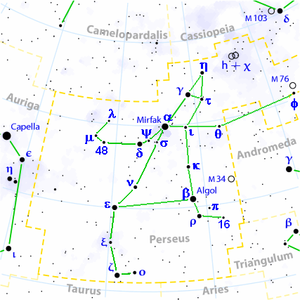
Epsilon Persei
Encyclopedia

Stellar classification
In astronomy, stellar classification is a classification of stars based on their spectral characteristics. The spectral class of a star is a designated class of a star describing the ionization of its chromosphere, what atomic excitations are most prominent in the light, giving an objective measure...
, third-magnitude star
Star
A star is a massive, luminous sphere of plasma held together by gravity. At the end of its lifetime, a star can also contain a proportion of degenerate matter. The nearest star to Earth is the Sun, which is the source of most of the energy on Earth...
in the constellation
Constellation
In modern astronomy, a constellation is an internationally defined area of the celestial sphere. These areas are grouped around asterisms, patterns formed by prominent stars within apparent proximity to one another on Earth's night sky....
Perseus
Perseus (constellation)
Perseus is a constellation in the northern sky, named after the Greek hero Perseus. It was one of the 48 constellations listed by the 2nd century astronomer Ptolemy, and remains one of the 88 modern constellations defined by the International Astronomical Union...
. Epsilon Persei is actually a multiple star system consisting of two main components: a blue main-sequence star of class B0.5V and a magnitude of 2.90, and a lesser white companion of class A2V and a magnitude of 3.92. The Epsilon Persei stellar system is located about 540 light-year
Light-year
A light-year, also light year or lightyear is a unit of length, equal to just under 10 trillion kilometres...
s from Earth
Earth
Earth is the third planet from the Sun, and the densest and fifth-largest of the eight planets in the Solar System. It is also the largest of the Solar System's four terrestrial planets...
.
The larger of the two stars has a mass 14 times that of our sun, a radius 7 times greater, a luminosity of about 25 thousand times our sun, and an estimated age of only 10 million years: massive stars have very short active life-spans. (Go to the bottom of the second external link for this and other details of the Epsilon Persei system.)

